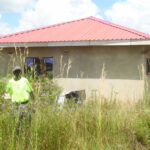A devastating mine shaft collapse at the disused Botha gold mine in Bindura has claimed the lives of seven artisanal miners. The tragedy, which unfolded on Saturday, has once again highlighted the perilous conditions faced by those engaging in illegal mining activities in Zimbabwe.
Police have confirmed the deaths and released the names of five of the victims: Leo Chapondama from Maganyani Village, Masembura; Zolani Nyani, 21, from Church Road, Chipadze; Samson Madyira, 20; Jacob Madyira Nongwe, 34; and Mathew Madyira, 23, all from Waerera Village, Masembura, Bindura. The identities of the remaining two victims are yet to be established.
National police spokesperson, Commissioner Paul Nyathi, issued a stark warning following the incident: “The Zimbabwe Republic Police warns the public against conducting mining activities at illegal shafts and disused mine sites as the current incessant rains have made the ground wet and prone to collapse and mine trappings.”
The government’s concerns regarding the safety of artisanal miners are not new. During the 2023 rainy season, a ban on artisanal mining activities was implemented in response to the increased risk of mine accidents. This tragedy serves as a grim reminder of the effectiveness, or lack thereof, of such measures.
The Minister of State for Provincial Affairs and Devolution in Mashonaland Central, Christopher Magomo, visited the site along with members of the Joint Operations Command.
Minister Magomo expressed deep concern, stating: “A dark cloud is hovering over the province. We imposed a ban and suspended mining operations at this site because it is a death trap. The shafts do not meet safety standards, and the distance between them is less than the required 35 metres.”
He further highlighted the site’s transformation into a hub for illegal activities, including illicit deals and drug peddling, and ordered the mine owner to address these issues.
Chief Inspector Simbarashe Mhanda provided further details during a briefing with the Minister. He reported that the shaft is 34 metres deep, with a 20-metre tunnel connecting to a German shaft. The collapse occurred when a mass of earth fell along this tunnel, trapping the miners underground.
“During the incident, a mass fell along the tunnel, trapping those who were underground. While we are uncertain about the exact number of victims, we know that seven were injured and five lost their lives. Three of the deceased are from the same family, one is from Chikwaka in Mashonaland East, and another is from Chipadze. We cannot confirm if all trapped individuals were rescued or if all bodies have been retrieved,” Chief Inspector Mhanda explained.
The recovery operation was hampered by safety concerns. Zanu PF DDC chairperson for Bindura, Cde Lucas Chigede, explained that local people manually recovered some bodies but ceased operations due to the perilous conditions of the shaft. “They did not reach the end of the shaft, so we are unsure how many people were inside and whether all were rescued,” he stated.
The lack of security at the site is also a matter of serious concern. Ms Theresa Mutandadzi alleged that security guards were bribed with US$100 to allow illegal miners access to the condemned area. She urged the government to station security officers at Kitsiyatota to prevent further tragedies.
The manager of Botha Mine, Mr Davis Isaiah, confirmed that the site had been condemned in September of the previous year. This condemnation, coupled with the ongoing illegal mining activities, paints a picture of systemic failure to enforce safety regulations and prevent access to dangerous areas. The condemned site, lacking a perimeter fence, remains a significant threat to life.
The incident at Botha Mine is a tragic illustration of the human cost of illegal mining in Zimbabwe. The desperate search for livelihoods in the face of economic hardship drives individuals to take extreme risks, often with fatal consequences. The lack of safety measures, coupled with alleged corruption and the failure to enforce existing regulations, creates a deadly environment for those seeking to eke out a living from the earth.
The government’s response, while acknowledging the severity of the situation, must now focus on implementing effective and sustainable solutions to prevent future tragedies of this nature. The lives lost serve as a stark reminder of the urgent need for stronger regulation, improved safety measures, and a more comprehensive approach to addressing the underlying economic pressures that drive individuals to engage in such dangerous activities.












